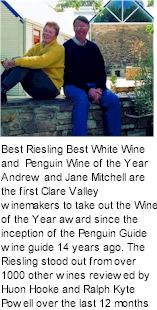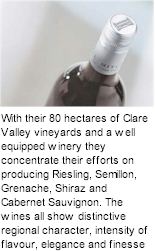


An old sandstone apple store was converted to serve as a rustic cellar door sales area. Continued growth has resulted in further development of the winery buildings and winemaking plant. Currently the prize harvests of premium fruit is crushed and processed in a well equipped modern winery. The imposing two-storey century-old family home sits amid the vineyards, overlooking the winery.

Andrew Mitchell was born on the Mitchell family vineyard. He studied Economics before the idea of returning and establishing the winery became a reality in 1975. Studying Wine Science at Riverina College (Charles Sturt University) in the late seventies helped crystallise Andrew's winemaking philosophies. Andrew has always sought to make wines of intensity of varietal fruit flavours and definitive regional character; wines which are balanced, drink well when young and have the capacity to age well.
Over the last few years Andrew has travelled extensively and spent vintage in France in order to develop his understanding of the great wines of the world. Together with his study of Anthropology and Classics, this experience will ensure the continued development and refinement of the Mitchell style. Andrew has recently taken on a 3 year term as Chairman of the Clare Valley Winemakers Association.
Jane Mitchell came to the industry from a nursing background. In 1977 she completed the Wine Production and Marketing Course at Roseworthy College (now University of Adelaide). With Andrew Mitchell she continues to develop the wine styles and marketing strategies. Jane focuses on the management and marketing of the business and continues to build the reputation of Mitchells as "One of the finest small wineries in Australia" -James Halliday

Jane's commitment to the wine industry has seen her take an active role in the Clare Winemakers Association, the group which promotes the area as a whole. In this role she was instrumental in initiating the Clare Gourmet Weekend as the first of its kind in Australia. This is a celebration of food and wine in the idyllic rustic surroundings of the Clare Valley. In recognition of her work in promoting the area and the wine industry generally, Jane was one of the first appointees of the South Australian Tourism Commission. Currently she sits on the Australian Regional Winemakers Forum, Wine Federation of Australia Council and has recently finished a 6 year term with the Australian Wine and Brandy Corporation Board.
The grapes for Mitchell wines come from the company's four local vineyards. Varieties planted are Riesling, Semillon, Shiraz, Merlot, Grenache and Cabernet. Soils are red-brown loam and clay over limestone. The altitude of these vineyards is between 300 and 400 metres and the average rainfall in the vicinity of 600mm, falling mostly in the winter (May to September)
The largest vineyard is located at Watervale, several kilometres south of the winery. Set on the exposed eastern slopes of undulating hills, with long rows of vines, this can be a very bleak place in the middle of winter at pruning time. This has led to it becoming known among the vineyard workers as Alcatraz - a place to do penance in the cold, wind and rain of a Clare winter. Alcatraz is particularly suited to the Riesling variety.
The other major vineyard is at the winery site at Sevenhill. Planted entirely to red grapes: Cabernet, Merlot and Cabernet Franc, this is the source vineyard for the Mitchell Cabernet. A new vineyard was acquired in 1995. This Watervale vineyard is planted with 50 year old dry grown Grenache and Riesling grapes. The most recent purchase is a 130 acre farm at Auburn which is being developed with vines and olives. In addition, selected growers are contracted to supply particular parcels of grapes to blend with the home grown fruit.
